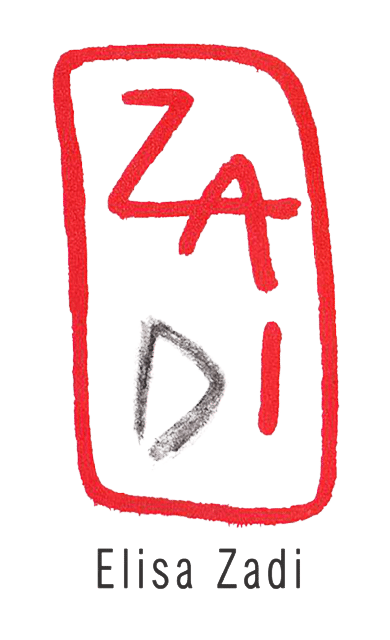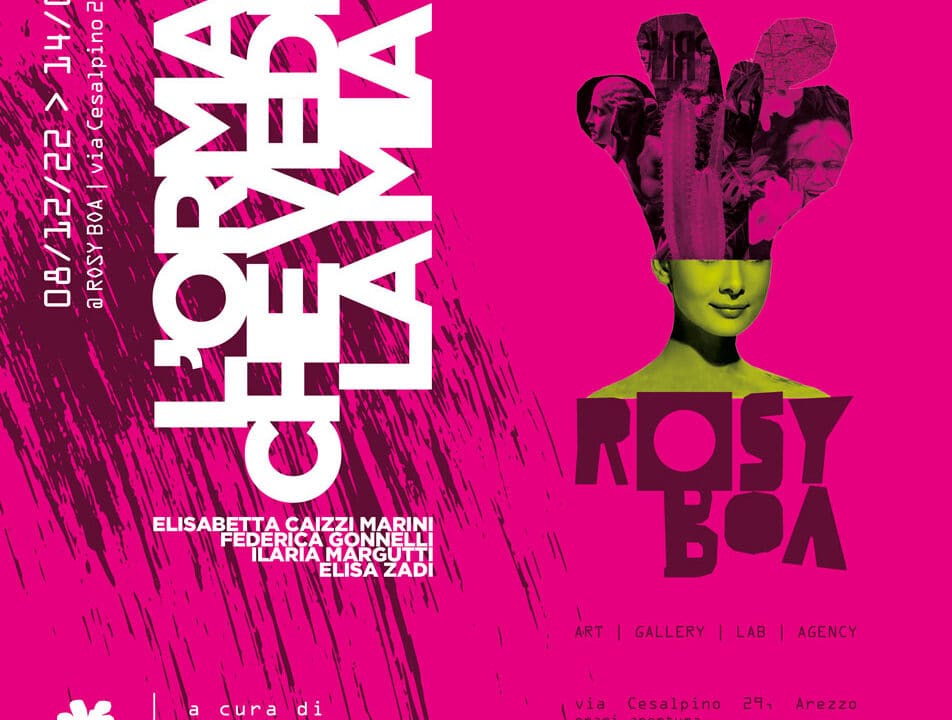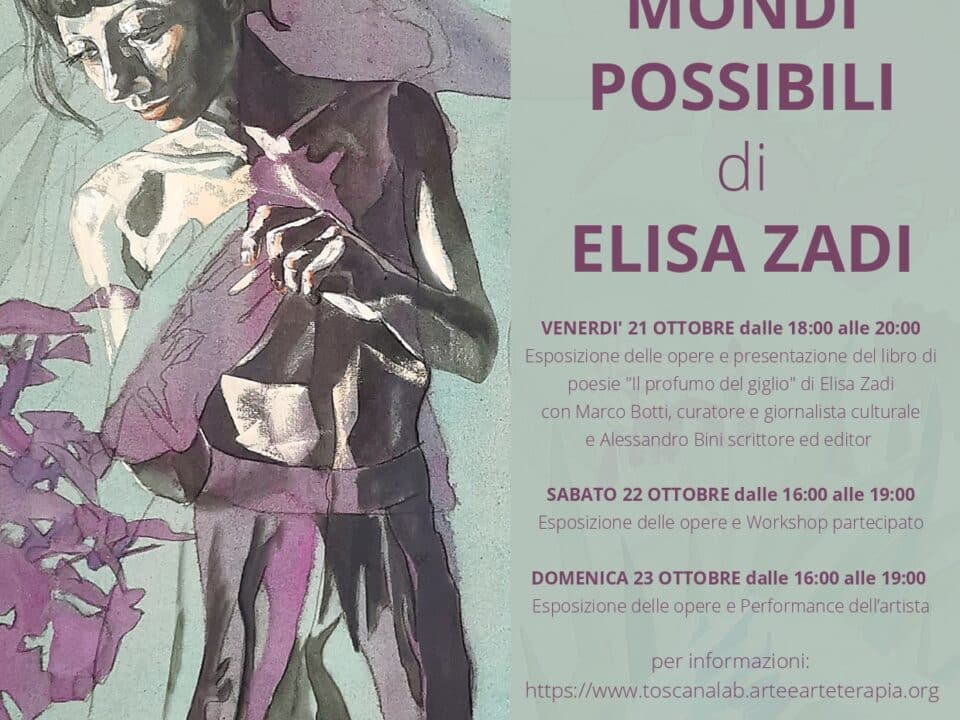“BLU GUADO”di ELISA ZADI
installazione interattiva ispirata alla “Madonna del parto”
capolavoro universale di Piero della Francesca
L’avventura per la creazione di quella che significativamente è intitolata “Blu Guado”, opera installativo-performativa appartenente a un genere che sta sempre più interessando e coinvolgendo Elisa Zadi nel suo percorso artistico, nasce dallo storico e suggestivo fatto che Piero della Francesca apparteneva ad una famiglia di tintori di stoffe: è verosimile che il maestro rinascimentale abbia utilizzato gli stessi pigmenti per la preparazione di alcuni colori per la pittura. All’epoca l’azzurro era ricavato dalla pianta di guado, molto preziosa per l’attenta lavorazione che necessitava, e che ancora oggi si mantiene come rarità per pochi appassionati. La particolarità della tintura al guado, rispetto alle altre piante, è che la colorazione del tessuto non avviene durante la bollitura ma gradualmente e rapidamente con la sua stesura all’aria: questa metamorfosi affascinante è stata per l’artista una scoperta magica, simbolica tanto da desiderare di condividerla con un pubblico. Il modello dell’abito appositamente creato per “Blu Guado”, tratto dal celebre affresco di Monterchi, è stato riadattato alle effettive proporzioni fisiche dell’artista, che ha preso di riferimento il proprio corpo anche per la realizzazione del manichino, mediante calco diretto in gesso, con un deciso e motivato senso d’immedesimazione. Tra l’altro, l’azzurro prodotto dal pigmento blu guado, scelto per la colorazione dell’abito-scultura, corrisponde proprio alla tonalità dell’abito della Madonna di Piero, qui interpretato tridimensionalmente e installato sull’apposito manichino.
The adventure of creating one, significantly entitled “Blu Guado”, an installation-performative work belonging to a genre that is increasingly affecting and involving Elisa Zadi in his artistic career, is Stoic and suggestive fact that Piero della Francesca belonged to a family of dyers of fabrics: it is likely that the Renaissance master has used the same pigments for preparation of certain colors for painting.At that time, light-blue was taken from the Guado plant, very valuable for the careful processing it needed and that still remains as a rarity for a few enthusiasts. The peculiarity of the dye at Guado, compared to other plants, is that the colour of the fabric doesn’t happen during boiling but gradually and rapidly with the preparation to the air: this fascinating metamorphosis for the artist was a find magical and symbolic, much to want to share it with an audience. The pattern of the dress specially created for “Blu Guado “, taken from the famous fresco of Monterchi, was adapted to the actual physical proportions of the artist, who has taken their bodies also to produce of the dummy, using direct cast in plaster, with a decided and reasoned sense of identification. Moreover, the light blue pigment manufactured by guado, chosen for the colour of the dress-sculpture, corresponds exactly to the shades of the dress of the Madonna di Piero, here played in three dimensions and installed on the appropriate length-mannequin.
 “Blu Guado” si compone di tre elementi: una grande tenda (che riprende un altro elemento fondamentale nell’iconografia pierfrancescana), l’abito-scultura contenuto in essa (dipinto e cucito riprendendo fedelmente il modello dell’affresco) e una tinozza per l’antica tecnica della tintura al guado. La performance inizia con il bagno di colore di una grande pezza: l’artista si posizionerà in ginocchio di fronte al pubblico, immergendo semi e pigmento di guado e iniziando a pronunciare frasi significative. Una volta fatto riemergere dall’acqua, il tessuto viene immediatamente appeso a un filo posto davanti alla tenda. Mentre il naturale miracolo dell’ossidazione inizia a far prendere la definitiva colorazione al tessuto, l’artista, collocatasi dietro di esso, con delle grandi forbici divide a metà la pezza, e dopo averne fissato le estremità apre anche la tenda, in modo da creare due simboliche aperture consecutive. Un susseguirsi di nuove gestualità e frasi dal sapore rituale inviteranno gli spettatori a compiere il passaggio e a entrare nella tenda. I partecipanti passeranno uno alla volta nella tenda e troveranno, al centro di essa, l’abito-scultura illuminato dal suo interno. Un taglio fisico e simbolico, anticipato dalla stoffa tagliata in precedenza, si riverbera nuovamente nell’abito diviso e aperto verticalmente all’altezza del ventre. A questo punto ogni spettatore coglierà dalla “luce” di questo ventre “i semi” (di guado o di calicantus) custoditi al suo interno, li prenderà e li porterà con sé fuori dalla tenda, diventando così responsabile della nascita di future piante.
“Blu Guado” si compone di tre elementi: una grande tenda (che riprende un altro elemento fondamentale nell’iconografia pierfrancescana), l’abito-scultura contenuto in essa (dipinto e cucito riprendendo fedelmente il modello dell’affresco) e una tinozza per l’antica tecnica della tintura al guado. La performance inizia con il bagno di colore di una grande pezza: l’artista si posizionerà in ginocchio di fronte al pubblico, immergendo semi e pigmento di guado e iniziando a pronunciare frasi significative. Una volta fatto riemergere dall’acqua, il tessuto viene immediatamente appeso a un filo posto davanti alla tenda. Mentre il naturale miracolo dell’ossidazione inizia a far prendere la definitiva colorazione al tessuto, l’artista, collocatasi dietro di esso, con delle grandi forbici divide a metà la pezza, e dopo averne fissato le estremità apre anche la tenda, in modo da creare due simboliche aperture consecutive. Un susseguirsi di nuove gestualità e frasi dal sapore rituale inviteranno gli spettatori a compiere il passaggio e a entrare nella tenda. I partecipanti passeranno uno alla volta nella tenda e troveranno, al centro di essa, l’abito-scultura illuminato dal suo interno. Un taglio fisico e simbolico, anticipato dalla stoffa tagliata in precedenza, si riverbera nuovamente nell’abito diviso e aperto verticalmente all’altezza del ventre. A questo punto ogni spettatore coglierà dalla “luce” di questo ventre “i semi” (di guado o di calicantus) custoditi al suo interno, li prenderà e li porterà con sé fuori dalla tenda, diventando così responsabile della nascita di future piante.
“Blu Guado ” consists of three elements: a large tent (which incorporates another key element of the iconography of Piero della Francesca), apparel-sculpture content n it (painting and sewing resuming faithfully fresco model) and a tub for the ancient technique of dyeing at the guando. The performance begins with the color of a great piece: the artist will go on her knees in front of the audience. “Blue Ford ” consists of three elements: a large tent (which incorporates another key element of the iconography pierfrancescana), apparel-sculpture content n it (painting and sewing resuming faithfully cool model) and a tub for the ancient technique of dyeing at the guado. Guado and seeds and plunging pigment starting to pronounce sentences. Once it emerges from the water, the tissue is immediately hanging by a thread in front of the tent . While the natural miracle of oxidation starts to take the final coloring to the fabric, the artist, collocatasi behind it, with large scissors bisects the piece, and after having fastened the ends also opens the curtain, to create two symbolic consecutive openings. A succession of new gestures and phrases invites viewers to take the ritual taste step and to enter the tent. Participants will enter in the tent one at a time, and in the middle of it, they will find the dress-sculpture lighted from within. A physical and symbolic cut, anticipated by the fabric cut earlier, is reflected back into the open belly height vertically divided and dress. At this point, every viewer will take the “light” of this belly, “seeds” ( Guado or Calicantus) kept inside, will take themselves and bring them outside the tent, becoming, thus, responsible for the birth of future plants.

Così scrive nella presentazione Marco Palamidessi:“Nel rendere omaggio al genio di Piero della Francesca, la nuova opera di Elisa Zadi, rappresentando in sé un inno alla fertilità nel senso più aulico e ampio, che va dalla procreazione alla genesi artistica, celebra un tema di fondamentale importanza, quello cioè dell’atto supremo, il gesto dei gesti che è appunto il nascere, il generare, il creare in tutti i suoi modi possibili, ma soprattutto artisticamente, cioè con la mente e con le mani. Vengono al mondo l’uomo, l’idea, il concetto universale, le opere i sentimenti e le cose. Gli artisti, quelli veri intendo, per mezzo della loro espressione, riescono a rinnovare ogni giorno la Creazione, sanno far sentire vivo un mondo, il nostro, che non è stato fatto in un solo istante, ma ogni volta che vi è sopraggiunto un artista degno di questo nome. Un’installazione, “Blu Guado”, che vuole ricordarci che creare è forse la maniera più alta di sentirsi vivi: si crea per essere ricreati continuamente da ciò che si fa, per mettere al mondo quei figli chiamati opere e dei quali gli artisti stessi sono figli a loro volta. Un modo, per chi vuole, di sentirsi più vicini all’universo, per coloro che non vogliono chiamarlo Dio. Ad ogni persona che vorrà intraprendere quest’avventura e condividerla prima di tutto con l’artista, il delicato compito di raccogliere il seme direttamente dal ventre che lo genera, per portarlo in un luogo, non importa se fisico o mentale, dove diventerà frutto e nuova vita. Come “levatrici”, andremo a cogliere il seme là dove questo germoglia, confrontandoci con un’opera che, attraverso la sua profonda ritualità, ci investe della responsabilità di essere portatori di luce, custodi del seme primordiale, protettori della vita che genera continuamente se stessa. E chi custodisce il seme della creazione è a sua volta egli stesso artista-creatore. “Blu Guado”, in fondo, è un’opera che ci ricorda che ogni giorno è un modo di venire al mondo, che ci fa cogliere l’idea che il nostro grembo, come la nostra mente, deve sempre essere fecondo, di luce, di semi, di vita”.
So writes Marco Palamidessi in presentation: “in paying tribute to the genius of Piero della Francesca, the new artwork of Elisa Zadi, making itself an ode to fertility in courtly and broad, ranging from procreation to the genesis of art, celebrates a theme of fundamental importance, namely that of Supreme Act, gesture gesture, which is, in fact, birth, generate the create in all its ways, but especially artistically, that is with the mind and the hands. Come into the world the man, the idea, the universal concept, the works, the feelings and things. The artists, the real ones I mean, by means of their expression, are able to renew every day creating, know how to feel alive a world, ours, that was not done in an instant, but whenever there is superadded an artist worthy of the name. An installation, “Blu Guado” which wants to remind us that create is, perhaps, the highest way to feel alive: you create to be recreated continously what you do, to give birth to the sons called works, and of which the artists themselves are children themselves. A way for those who want to, to feel closer to the universe, for those who don’t want to call him God. Every person who wants to start this adventure and share it first of all with the artist, the delicate task of collecting the seed direct from the womb that creates it, to bring it to a place, whether physical or mental, where will become fruit and new life. As “midwives”, we will seize the seed germinates, making a comparison with a work that it, through its deep ritual, it invests the responsibility to be bearers of light, guardians of the primeval seed. protectors of life that continuously generates itself. And whoso keepeth the seed of creation is in turn himself artist-creator. Basically, “Blu Guado”, is a work that reminds us that every day is one way to come into the world, that makes us grasp the idea that our womb, how our minds, should always be fruitful, of light, of seeds, of life .
.
http://zadielisa.blogspot.it/2016/08/blu-guado.html
03 Settembre 2016 – La Barbagianna – una Casa per l’Arte Contemporanea, Pontassieve, Firenze.
Ph Marco Palamidessi
 |
 |
 |
 |
 |
 |
 |
 |
http://zadielisa.blogspot.it/2016/11/blu-guado-prato.html
01 Dicembre 2016 – Biblioteca Lazzerini, Prato.
Con la straordinaria partecipazione di Alessandra Borsetti Venier e Andrea Vannicola
Ph Giovanna Sparapani e Marco Palamidessi
 |
 |
|
 |
|
 |
|
 |
|
 |
|
 |
|
 |
|
 |
|
 |
|
 |
 |
 |
 |
 |
 |
https://zadielisa.blogspot.com/2020/01/t-essere-in-fiore.html
03 Febbraio 2020, Firenze – presso Toscana ArtLab
Con la partecipazione di Sara Freschi e Beatrice Bartolozzi
 |
 |
 |
 |
 |
 |
 |
 |
 |
 |
 |
 |
 |
 |
 |
 |
 |
 |

|






